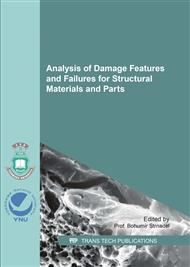p.70
p.76
p.82
p.88
p.94
p.99
p.105
p.110
p.116
Effects of Slip Ratio on Damage and Microcracks in Carburized SCM420 Steel under Rolling Contact Fatigue
Abstract:
Damage and microcracks formed by rolling contact fatigue (RCF) were characterized for carburized SCM420 steel. A large number of microcracks were detected beneath the contact surfaces after RCF. The microcrack generation and strain distribution beneath the contact trail depended on the slip ratios of 0 %, -20% and -40 % in the roller pitting test. Such severe slip increased shear strain in the region higher than 160 µm in depth from the contact surface. Compressive stress also gave rise to strain in the region near the surface up to 100 µm in the depth. Those strain gradients may cause a strain incompatibility at the transition layer in which a crack branching was detected.
Info:
Periodical:
Pages:
94-98
Citation:
Online since:
June 2017
Authors:
Price:
Сopyright:
© 2017 Trans Tech Publications Ltd. All Rights Reserved
Share:
Citation:


